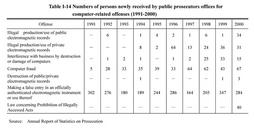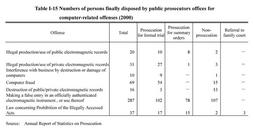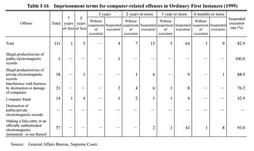| Previous Next Index Image Index Year Selection | |
|
|
1. Trends in computer-related offenses and disposition by public prosecutors offices and courts The term"computer-related offenses"is a very broad concept that includes all kinds of offenses related to computers. In this section, we will examine major offenses that are committed by misusing computer technology and telecommunication technology, which have recently been called "hi-tech offenses. "
Hi-tech offenses are roughly categorized into (1) offenses involving computers or electromagnetic records (computer offenses in the narrow sense), (2) offenses using a computer network (network offenses), and (3) Law Concerning Prohibition of Illegally Accessed Acts (Unauthorized Computer Access Law). Category (1) includes illegal production and use of various electromagnetic records, interference with business by destruction or damage of computers, and computer fraud. Category (2) includes fraud using the Internet and distribution of child pornography (violation of the Law against Child Prostitution and Pornography). Table I-14 shows the trends in the number of persons newly received by public prosecutors offices over the last decade for computer-related offenses including illegal production of electromagnetic records. Overall, the number of persons received for computer-related offenses has increased rapidly over the last decade, though there were some increases and decreases for each offense. As for computer-related offenses, because the same person usually commits several offenses, the number of cleared cases shows a significantly increasing trend. According to the Community Safety Bureau of the National Police Agency, the total number of cleared cases of hi-tech offenses was 63 in 1994, 176 in 1996, 415 in 1998, and 559 in 2000. Table I-14 Numbers of persons newly received by public prosecutors offices for computer-related offenses (1991-2000) Table I-15 shows the number of persons finally disposed by public prosecutors offices for computer-related offenses in 2000 by type of disposition. The prosecution rates exceed 50% for all types of computer-related offenses except for destruction of public/private electromagnetic records, and the rate reached 69.4% for the total number of computer-related offenses.Table I-15 Numbers of persons finally disposed by public prosecutors offices for computer-related offenses (2000) Table I-16 shows the term of imprisonment with labor sentenced by ordinary first instances for computer-related offenses in 1999. The suspended execution rate for those sentenced to imprisonment with labor for computer fraud was 42.9% in 1999 and 64.7% in 2000.Table I-16 Imprisonment terms for computer-related offenses in Ordinary First Instances (1999) |


